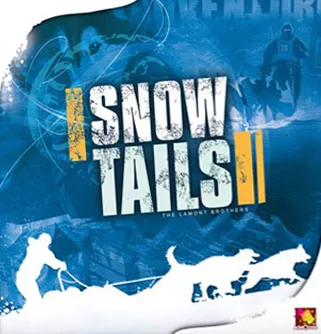Version 1.1
- All regular rules apply: the bot rules function as a layer on top of the existing ruleset. Some exceptions do exist, and will be highlighted accordingly.
- No rule is modified for human players. Only cardboard opponents are afforded some leeway...
The Dice
Each bot is activated with a roll of two six-sided dice (2d6), in two different colors. One of them is the Movement die, the other the Control die. - The Movement die indicates the bot’s Speed—how many spaces it will move.
- The delta between the two dice shows how many drifts must be performed during that move. If both dice are equal, no drift occurs: the sled is balanced! (And it does benefit from its movement bonus.)
- In some situations (see below), the Control die also indicates in what direction drifts will take place. In those cases, the bot will drift towards the outside of the track (in relation to the next curve) when the Control die is higher than the Movement die, and towards the inside of the track when the Control die is lower than the Movement die.
Movement
Move each bot-driven sled as far as possible within the confines of the game’s regular rules. Prioritize distance (towards the finish line) over angle inside a corner. This means that sometimes a bot will drive itself into a dead end rather than go for a better position for next turn; that’s ok. If two different destinations are valid, prioritize the one most on the inside of the track.- A bot’s minimum Speed is always its position in the race. If you roll a speed that’s lower than a bot’s position, physically rotate the Movement die so that it shows the correct number. (So a bot in fourth place can roll 4, 5 or 6—if the Movement die shows any other result, rotate it so that the 4 is showing.)
- If the sled starts on a corner piece, apply drifts towards the inside of the corner.
- If the sled’s move would take it onto a corner piece (even if another sled blocks the intended path—imagine the track is empty for this visualization), apply drifts towards the inside of that next corner.
- If both situations apply, prioritize the next corner.
- In any other contradictory situation, prioritize the current corner.
- (You might see that rare occurrence with two consecutive but opposed corners, where going inside the current corner takes you to the next track piece, but moving towards the inside of the next corner would leave you on the current track piece.)
- Note that the above points also apply to obstacle pieces such as the Snow Drift. In that case, replace “inside of the corner” with “safe side of the track.”
- Otherwise, apply drifts according to the Control die (as explained above).
- Once a drift direction is determined, it remains the same for the entire turn.
- Delayed Drift: If a drift would take a sled outside the track, move it forward instead. (That drift becomes a forward movement.) Bots are not stopped by the sides of tracks.
- Should the sled then reach an opening that allows it to drift, resume drifting as prescribed by the dice roll.
- A bot that reaches a dead end must stop.
- If a sled starts its turn in a dead end and gets a balanced dice roll (both dice are equal), it’s allowed to drift 1 space towards the inside of the track and then keep going if that move freed the sled. (And still use its movement bonus if applicable!)
- That initial “free drift” doesn’t count as a direction change, and so the sled could conceivably start drifting in the other direction during its move. This is the only case in which a bot could be viewed as zigzagging.
Movement Exceptions
- Bots are not restrained by speed limits. (Those guys are fearless!)
- Bots never incur damage.
- Bots ignore trees in their path.
- Bots are not stopped by the side of a track, but are stopped by other sleds.
Difficulty Adjustments
The rules outlined above should provide plenty of challenge and chaos. Sometimes bots will roll great, sometimes poorly, but overall the resulting race should be fun and exciting.However, should you desire to up the ante, you can pull one or more of the following levers.
- Instead of selecting your start position at random, place your sled in a higher number (not necessarily 5!).
- Give a +1 or +2 move boost to any bot that starts its turn behind your sled.
- Provide bots that start their turn in a dead end with 2 free drifts instead of 1.
(Warning: this makes bots REALLY powerful.)
Design Notes
There’s not much to say here, except that I’ve always wanted a way to play Snow Tails with five sleds on the race track, no matter how many friends I have around the table.I like that the 2d6 mechanic mimics the pull of the two dogs on the sled, like the card play does for human players. There’s nothing that duplicates the effect of brakes, though; but since bots don’t care for speed limits, they don’t need to slow down.
Also, because the minimum Speed of a sled is equal to its position in the race, it tends to force stragglers to swerve towards the inside of the track (which is, of course, the ideal move we all strive for). You will sometimes get an incompetent bot in 5th place who will manage to roll a 6 on the Control die and drift against the curve: enjoy those occasional blunders, because bot-operated sleds never stay behind for very long...
# # #
